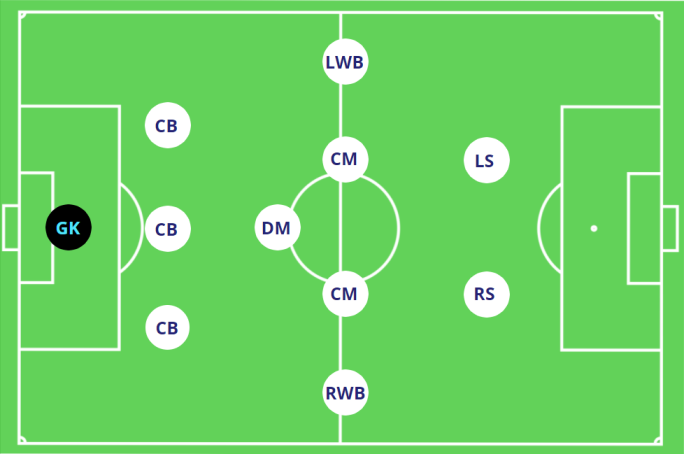
In terms of formations and tactics, one of the major surprises of the 2018-19 season in Europe has been the rise of the 3-1-4-2. Although the formation is only a very minor spin on the popular 3-5-2, seemingly a host of teams around Europe have implemented this formation, and not just in Italy where back-three systems are commonplace. Top clubs like Eintracht Frankfurt and even Atletico Madrid have used this formation in 2018-19 and with the continuous rise of positional fluidity and playing out from the back, the rise of the 3-1-4-2 looks likely to continue. Here is The Mastermind’s Tactical Analysis of the 3-1-4-2.
KEY ASPECTS
The 3-1-4-2 is very similar to a traditional 3-5-2, with the main difference coming in the form of two defensive midfielders in behind a number ten in the 3-5-2, instead of the single pivot in the 3-1-4-2. The 3-5-2 also has the distinction for some teams of deploying a flat three in midfield like Lazio or Wolverhampton do, while the 3-1-4-2 is very reliant on four more attack-minded players who need to be very adaptive in defensive transitions. In an era of increased versatility, adaptability and dynamism among footballers, the 3-1-4-2 becomes a very demanding and complex formation for everyone involved. On paper, this formation also looks very attack-minded, but it’s important to remember that teams deploying this formation may very easily become a 5-3-2 in defense.
The key to the 3-1-4-2 and one of the reasons why the formation has been so successful for teams like Sevilla, Atletico Madrid and Eintracht Frankfurst this season, is having a pivot who can control and dictate possession. Like the 4-1-4-1, the defensive midfielder (the pivot or number 6) is absolutely instrumental in dictating what happens in this formation. This is often mechanically produced through the centre backs pushing wide and the fullbacks pushing high, opening up all the space in the world for the player everyone wants on the ball, the pivot. Atletico’s Rodrigo and Sevilla’s Ever Banega have both done this role effectively in 2018-19, while another good example is Lazio’s Lucas Leiva. Another key aspect to the formation is the dynamism and movement it requires of the fullbacks, who are pushed arguably even higher than they might be in a 3-5-2 or 3-4-3. Players like Saul Niguez and Santiago Arias have operated in this position very effectively for Atletico, while Frankfurt’s Danny da Costa and Filip Kostic have also enjoyed a meteoric rise this season operating in the role.
WHY THE RISE?
A major reason why many managers may be deploying this intricate system is because of its ability to accommodate two strikers in a team. As talked about in Best Formations for 11v11, there has been a major shift away from two striker systems in the past decade. For a while, the 4-4-2 was the formation everyone played everywhere you traveled. Then came along the 4-2-3-1 and 4-3-3, and a shift started to occur away from two-striker systems. This has been followed more recently by the rise of the 4-1-4-1 and a resurgence in popularity again of back-three systems, which were particularly popular before the 4-4-2 became commonplace. But unlike the other systems mentioned, the 3-1-4-2 accommodates for two-strikers in a team just like the once standard 4-4-2. This has allowed teams like Atletico Madrid to adapt their style and deploy the formation. Even more, what may be making this formation so popular is its ability to also accommodate a midfield triangle, just like the 4-3-3 and 4-2-3-1. Check out Playing in a Midfield Three for more on what this can provide for a team.
With the recent rise of the 4-1-4-1 and the positional fluidity of the midfield triangle in the formation, it is actually unsurprising that the 3-5-2 has adapted into a 3-1-4-2 to mirror the same principles. The central attacking midfielders can get closer to the strikers, while having the knowledge that a defensive midfielder is in behind them. For teams that are heavily possession based, this may be an excellent option as the defensive midfield can screen the back three when playing out from the back, creating a constant diamond. Meanwhile the wing-backs can push high and the central-attacking-midfielders can coordinate their movements on when to drop deep. In this formation there should be constant width offered by the wing-backs in possession, while the central players can easily create overloads in the attacking third. If one wing-back has the ball high up the field in a wide area, a minimum of four players (two attacking mid’s and two strikers) may be surging into the box to get on the end of it. This is something that the 4-1-4-1 also succeeds in accomplishing, but perhaps with two strikers this pattern of play becomes even deadlier in the 3-1-4-2.
Atletico’s exuberant manager Diego Simeone has always garnered attention and praise for his pragmatic approach in sticking by the traditional 4-4-2/4-4-1-1. Now with the rise in the 3-1-4-2, Atletico can play the exact same way, just with fullbacks playing like wide midfielders and an extra centre-half. Eintracht Frankfurt meanwhile have mostly favoured a more traditional 3-5-2, but have never been afraid to chop and change game by game. When star man Ante Rebic is out, Frankfurt have been quick to implement the formation. La Liga giants Sevilla have also used the system of play more regularly throughout 2018-19.
Embed from Getty ImagesIn an era of ever-changing formations, the 3-1-4-2 is becoming a more and more popular option for managers to utilize. The likes of Sevilla, Eintracht Frankfurt and Atletico Madrid are just a few of the many clubs using this formation around Europe in 2018-19. Formations often go through trends and phases, leading to a never-ending cycle of tactical nuances. Perhaps the latest of these is a rise in the intricate, complex and dynamic 3-1-4-2.
For more articles like this, check out our Coaching section. Thanks for reading and see you soon!
You might also enjoy
-> 3 Ways To Play in a 4-5-1.
-> 3 Ways To Play 3-5-2
WANT MORE?

3-1-4-2 GAME MODEL EXAMPLE
This game model example showcases what Rhyspect FC looks to do in each third of the pitch in all three defensive phases, and all three attacking phases in a 3-1-4-2 formation. The game model also provides a brief look into set-pieces, transitions, and player characteristics. To see a preview of the game model, click the download preview button below. To purchase the game model, click the ‘Purchase’ button below.


9 thoughts on “The Rise of the 3-1-4-2”